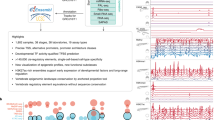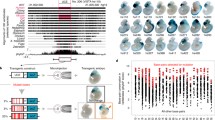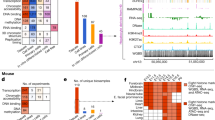Abstract
cis-Regulatory analysis (CRA) is the precise identification of the cis-acting genomic sequences regulating gene transcription. As such, CRA provides essential mechanistic insight into key biological processes such as development. The first phase of this protocol involves identification of a large (∼100 kb) clone of genomic material surrounding the gene of interest and use of this clone to establish a reliable and unambiguous reporter assay. In the second phase, phylogenetic footprinting is used to identify candidate regulatory modules; these genomic sequences are then recursively tested for reporter activity. In the final phase, potential transcription factor binding sites are identified and disrupted in reporter constructs for individual testing. The strengths of this method reflect the use of large clones containing all relevant genomic regulatory sequences to establish a reporter assay with high fidelity. Given these foundational elements, predicted or suspected regulatory inputs can be rigorously tested and novel regulatory inputs identified. Although the expected time line varies greatly with the depth of information required, results may be obtained in as little as 4–6 months, but more detailed analyses will require several years to complete.
This is a preview of subscription content, access via your institution
Access options
Subscribe to this journal
Receive 12 print issues and online access
$259.00 per year
only $21.58 per issue
Buy this article
- Purchase on Springer Link
- Instant access to full article PDF
Prices may be subject to local taxes which are calculated during checkout


Similar content being viewed by others
References
Davidson, E.H. The Regulatory Genome: Gene Regulatory Networks in Development and Evolution. (Academic Press, San Diego, California, 2006).
Davidson, E.H. et al. A genomic regulatory network for development. Science 295, 1669–1678 (2002).
Smith, J., Theodoris, C. & Davidson, E.H. A gene regulatory network subcircuit that drives a dynamic pattern of gene expression. Science 318, 794–797 (2007).
Smith, J., Kraemer, E., Liu, H., Theodoris, C. & Davidson, E. A spatially dynamic cohort of regulatory genes in the endomesodermal gene network of the sea urchin embryo. Dev. Biol. 313, 863–875 (2008).
Yuh, C.H., Dorman, E.R., Howard, M.L. & Davidson, E.H. An otx cis-regulatory module: a key node in the sea urchin endomesoderm gene regulatory network. Dev. Biol. 269, 536–551 (2004).
Minokawa, T., Wikramanayake, A.H. & Davidson, E.H. cis-Regulatory inputs of the wnt8 gene in the sea urchin endomesoderm network. Dev. Biol. 288, 545–558 (2005).
Ransick, A. & Davidson, E.H. cis-Regulatory processing of Notch signaling input to the sea urchin glial cells missing gene during mesoderm specification. Dev. Biol. 297, 587–602 (2006).
Lee, P.Y., Nam, J. & Davidson, E.H. Exclusive developmental functions of gatae cis-regulatory modules in the Strongylocentrotus purpuratus embryo. Dev. Biol. 307, 434–445 (2007).
Revilla-i-Domingo, R., Minokawa, T. & Davidson, E.H. R11: a cis-regulatory node of the sea urchin embryo gene network that controls early expression of SpDelta in micromeres. Dev. Biol. 274, 438–451 (2004).
Amore, G. & Davidson, E.H. cis-Regulatory control of cyclophilin, a member of the ETS-DRI skeletogenic gene battery in the sea urchin embryo. Dev. Biol. 293, 555–564 (2006).
Alon, U. Network motifs: theory and experimental approaches. Nat. Rev. Genet. 8, 450–461 (2007).
Alon, U. An Introduction to Systems Biology: Design Principles of Biological Circuits (Chapman & Hall/CRC, London, 2006).
Davidson, E.H. et al. A genomic regulatory network for development. Science 295, 1669–1678 (2002).
Oliveri, P. & Davidson, E.H. Gene regulatory network controlling embryonic specification in the sea urchin. Curr. Opin. Genet. Dev. 14, 351–360 (2004).
Clyde, D.E. et al. A self-organizing system of repressor gradients establishes segmental complexity in Drosophila. Nature 426, 849–853 (2003).
Stanojevic, D., Small, S. & Levine, M. Regulation of a segmentation stripe by overlapping activators and repressors in the Drosophila embryo. Science 254, 1385–1387 (1991).
Stathopoulos, A. & Levine, M. Genomic regulatory networks and animal development. Dev. Cell 9, 449–462 (2005).
Nasevicius, A. & Ekker, S.C. Effective targeted gene 'knockdown' in zebrafish. Nat. Genet. 26, 216–220 (2000).
Oliveri, P., Carrick, D.M. & Davidson, E.H. A regulatory gene network that directs micromere specification in the sea urchin embryo. Dev. Biol. 246, 209–228 (2002).
Revilla-I-Domingo, R., Oliveri, P. & Davidson, E.H. A missing link in the sea urchin embryo gene regulatory network: hesC and the double-negative specification of micromeres. Proc. Natl. Acad. Sci. USA 104, 12383–12388 (2007).
Cameron, R.A. et al. A sea urchin genome project: sequence scan, virtual map, and additional resources. Proc. Natl. Acad. Sci. USA 97, 9514–9518 (2000).
Nam, J. et al. cis-regulatory control of the nodal gene, initiator of the sea urchin oral ectoderm gene network. Dev. Biol. 306, 860–869 (2007).
Yuh, C.H. et al. Patchy interspecific sequence similarities efficiently identify positive cis-regulatory elements in the sea urchin. Dev. Biol. 246, 148–161 (2002).
Bolouri, H. & Davidson, E.H. Transcriptional regulatory cascades in development: initial rates, not steady state, determine network kinetics. Proc. Natl. Acad. Sci. USA 100, 9371–9376 (2003).
Cameron, R.A. et al. An evolutionary constraint: strongly disfavored class of change in DNA sequence during divergence of cis-regulatory modules. Proc. Natl. Acad. Sci. USA 102, 11769–11774 (2005).
Johnson, D.S., Mortazavi, A., Myers, R.M. & Wold, B. Genome-wide mapping of in vivo protein-DNA interactions. Science 316, 1497–1502 (2007).
Cameron, R.A. et al. Unusual gene order and organization of the sea urchin hox cluster. J. Exp. Zoolog. B Mol. Dev. Evol. 306, 45–58 (2006).
Yu, D. et al. An efficient recombination system for chromosome engineering in Escherichia coli. Proc. Natl. Acad. Sci. USA 97, 5978–5983 (2000).
Rast, J.P. Transgenic manipulation of the sea urchin embryo. In Developmental Biology Protocols Vol. II (eds. Tuan, R.S. & Lo, C.W.) (Humana Press, Totowa, New Jersey, 2000).
Range, R.C., Venuti, J.M. & McClay, D.R. LvGroucho and nuclear beta-catenin functionally compete for Tcf binding to influence activation of the endomesoderm gene regulatory network in the sea urchin embryo. Dev. Biol. 279, 252–267 (2005).
Castro, B., Barolo, S., Bailey, A.M. & Posakony, J.W. Lateral inhibition in proneural clusters: cis-regulatory logic and default repression by Suppressor of Hairless. Development 132, 3333–3344 (2005).
Imai, K.S., Levine, M., Satoh, N. & Satou, Y. Regulatory blueprint for a chordate embryo. Science 312, 1183–1187 (2006).
Acknowledgements
Many thanks to Eric H. Davidson in whose laboratory this protocol was developed and who provided the primary logical arguments underpinning this methodology. Many thanks also to members of the Eric H. Davidson laboratory group, past and present, for their contributions. The author thanks Jongmin Nam, Smadar Ben-Tabou De-Leon and Andrew Ransick for thoughtful discussions, insights and suggestions. Thanks also to Jenifer Croce and Andrew Ransick for a critical reading of the article. This work is supported by NIH GM-75089. The author is supported by a California Institute of Regenerative Medicine fellowship.
Author information
Authors and Affiliations
Corresponding author
Rights and permissions
About this article
Cite this article
Smith, J. A protocol describing the principles of cis-regulatory analysis in the sea urchin. Nat Protoc 3, 710–718 (2008). https://doi.org/10.1038/nprot.2008.39
Published:
Issue Date:
DOI: https://doi.org/10.1038/nprot.2008.39
This article is cited by
-
Monte Carlo analysis of an ODE Model of the Sea Urchin Endomesoderm Network
BMC Systems Biology (2009)
-
A protocol for unraveling gene regulatory networks
Nature Protocols (2008)
Comments
By submitting a comment you agree to abide by our Terms and Community Guidelines. If you find something abusive or that does not comply with our terms or guidelines please flag it as inappropriate.



